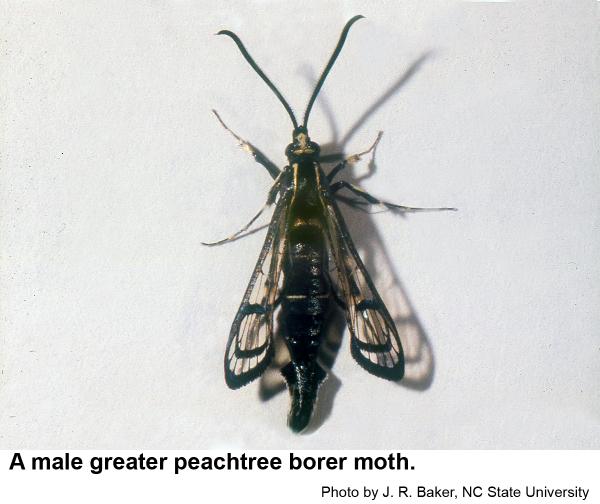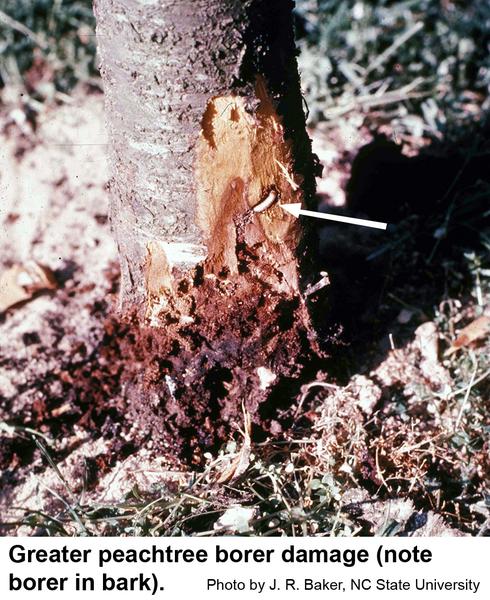General Information
For decades the greater peachtree borer, Synanthedon exitisoa, was known simply as the peachtree borer. These borers are caterpillars of a dark, clearwinged moth. The moths fly during the day and closely resemble paper wasps (the moths do not sting). The 3/4-inch-long females are bluish black with an orange band on the abdomen. Male moths are smaller with transparent areas on the wings. These moths emerge throughout the growing season, but the great majority of them are in flight between August 15 and September 15. Female moths lay eggs in crevices or under rough bark on the tree trunk around the lower portion of the trunk usually near the crown. Some females can lay 400 to 900 (perhaps up to 1200 eggs). More than half of the eggs are laid during the first day. The moths live about 5 days. Larvae hatch in 8 to 9 days and bore into the main trunk and larger roots near the soil surface. They feed on cambium tissue and eventualy weaken or kill the tree. Borers overwinter as larvae in the tunnels and resume feeding the following spring. Most individuals complete development during the summer. Part of the population may require two years to complete the life cycle. Pupation occurs within a silken cocoon covered with chewed wood and frass.
Host Plants
Greater peachtree borers infest cherries, cherry laurel, flowering peach, ornamental plums, peach, plum and other stone fruits. This pest prefers healthy plants. They can be detected by the presence of gum and frass around the base of a tree, sometimes in surprisingly large amounts. The gum around new feeding damage is soft, sticky, and light brown in color, whereas older gum is hard and dark brown. Symptoms are often first noticed in the spring when the borers are maturing. Greater peachtree borers feed on cambium tissue and eventualy weaken or kill trees completely.
Residential Recommendation
Although greater peachtree borers prefer healthy plants, healthy plants are able to overcome damage more readily than stressed plants. After taking a soil sample from beneath a host tree, be sure not to exceed the recommendations of amendments recommended in the soil sample test results. To prevent greater peachtree borers, use an insecticide that has permethrin or one of the other pyrethroids (such as bifenthrin, esfenvalerate or cyfluthrin) as the active ingredient. Thoroughly saturate the bark at the base and lower part of the trunk several times during the season, but especially before and after the peak moth emergence about the first of September. Chlorantraniliprole (Acelepryn) is a systemic insecticide labeled for clearwing borers. David Nielsen at Ohio State University found that Acelepryn gave very good control when applied at the first of the growing season.
Other Resources
- Peachtree Borers in the Home and Commercial Peach Orchard. Mizell, R. F. III. 2003. Univ. Florida IFAS Extension, EDIS. ENY-691
- Peachtree Borer (Synanthedon exitiosa). Nielsen, D. 2009. p. 20 IN Palmer, C. and Vea, E. 2010. Hachi-Hachi 15EC (tolfenpyrad) Crop Safety and Efficacy. IR-4 Ornamental Horticulture Program.
- Common name: peachtree borer, scientific name: Synanthedon exitiosa (Say) (Insecta: Lepidoptera: Sesiidae). Strickland, J. S. 2014 update. Featured Creatures. Entomology & Nematology, FDACS/DPI, EDIS, Pub. No. EENY-260.
- Extension Plant Pathology Publications and Factsheets
- Horticultural Science Publications
- North Carolina Agricultural Chemicals Manual
For assistance with a specific problem, contact your local N.C. Cooperative Extension Center.
Publication date: July 1, 2013
Revised: April 19, 2023
Recommendations for the use of agricultural chemicals are included in this publication as a convenience to the reader. The use of brand names and any mention or listing of commercial products or services in this publication does not imply endorsement by NC State University or N.C. A&T State University nor discrimination against similar products or services not mentioned. Individuals who use agricultural chemicals are responsible for ensuring that the intended use complies with current regulations and conforms to the product label. Be sure to obtain current information about usage regulations and examine a current product label before applying any chemical. For assistance, contact your local N.C. Cooperative Extension county center.
N.C. Cooperative Extension prohibits discrimination and harassment regardless of age, color, disability, family and marital status, gender identity, national origin, political beliefs, race, religion, sex (including pregnancy), sexual orientation and veteran status.



